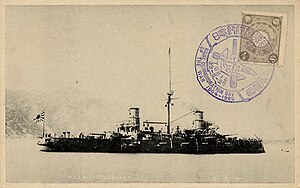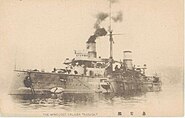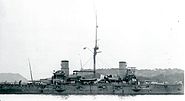| Japanese cruiser Kasuga | |
|---|---|
 Armoured cruiser Kasuga | |
| Career | |
| Name: | Kasuga |
| Ordered: | 1903 Fiscal Year |
| Builder: | Ansaldo Yards, Genoa, Italy |
| Laid down: | 10 March 1902 |
| Launched: | 22 October 1902 |
| Commissioned: | 7 January 1904 |
| Struck: | 30 November 1945 |
| Fate: |
Sunk, 18 July 1945 Later refloated and broken up for scrap |
| General characteristics | |
| Class & type: | Kasuga-class armored cruiser |
| Displacement: | 7,698 long tons (7,822 t) |
| Length: |
108.8 m (356 ft 11 in) w/l 111.73 m (366 ft 7 in) o/a |
| Beam: | 18.9 m (62 ft 0 in) |
| Draft: | 7.32 m (24 ft 0 in) |
| Propulsion: |
2 shaft Reciprocating Vertical Triple Expansion (VTE) Engines 13,500 shp (10,100 kW) |
| Speed: | 20 knots (23 mph; 37 km/h) |
| Range: | 5,500 nmi (10,200 km) at 10 kn (12 mph; 19 km/h) |
| Complement: | 600 |
| Armament: |
• 1 × BL 10 inch gun Mk I – IV gun (forward) • 2 × 20.3 cm/45 Type 41 naval gun (aft) • 14 × QF 6 inch /40 naval guns • 10 × QF 12 pounder 18 cwt naval guns • 6 × QF 3 pounder Hotchkiss guns • 2 × Maxim guns • 4 × 457 mm (18 in) torpedo tubes |
| Armor: |
Belt: 70–150 mm (2.8–5.9 in) Deck: 25–38 mm (0.98–1.50 in) Barbette: 100–150 mm (3.9–5.9 in) Casemate & Conning tower: 150 mm (5.9 in) |
Kasuga (春日) was the lead ship of the Kasuga-class armored cruisers of the Imperial Japanese Navy, designed and built by Ansaldo Yards, Genoa, Italy, where the type was known as the Giuseppe Garibaldi-class cruiser. She was named after a sacred mountain in Nara prefecture. Designed as a cross between a battleship and a cruiser, but with a very small displacement, the Kasuga-class ships had the ability to stand in the line of battle and the speed to avoid action with battleships. Their armor was only 6 inches (150 mm) thick but covered a far greater percentage of the hull than previous armored cruiser designs. Kasuga had a sister ship, the Nisshin.
Background[]
Nisshin was the next-to-last last of the Giuseppe Garibaldi-class cruiser armored cruisers to be built. The first ship in the class had been completed in 1895 and the series had enjoyed considerable export success, and had evolved with improvements over the years based on operational experience.
Originally ordered by the Italian Navy as Mitra in the spring of 1902, the vessel was sold immediately after launch to the Argentine Navy, and renamed Rivadavia. However, the possibility of war between Argentina and Chile abated before the vessel was completed, making it surplus.[1] The Italian government attempted to sell the ship to Russia, but in December 1903 rejected the Russian counter-offer. The Japanese government quickly stepped in and purchased it due to increasing tensions with Russia.
The keel was laid in 10 March 1902, and the vessel was launched on 22 October 1902. The ship was designated Kasuga on 7 January 1904.[1]
Design[]
Kasuga had an overall length of 111.73 m (366 ft 7 in), and beam of 18.9 m (62 ft 0 in), with a nominal displacement of 7,698 long tons (7,822 t) and draught of 7.4 m (24 ft 3 in).[1] The ship was armored with Italian-made Terni Steel, similar to Krupp armor in performance.
Kasuga was powered by two vertical triple expansion steam engines made by Ansaldo, with eight cylindrical boilers, driving two screws. This type of locomotive boiler was considered obsolete at the time, but was selected to provide standardization with other ships in the Argentine Navy. The engine had a nominal output of 13,500 shp (10,100 kW), which yielded a theoretical speed of 20.05 kn (23.07 mph; 37.13 km/h) (although for practical purposes, Kasuga could only make around 18 kn (21 mph; 33 km/h)). Her main armament consisted of one 254-mm L/45 Armstrong gun in a single mount in the bow and two 20.3 cm/45 Type 41 naval guns, paired in a gun turret in the stern. Secondary armament consisted of 14 QF 6 inch /40 naval guns and ten QF 12 pounder 18 cwt naval gun and six QF 3 pounder Hotchkiss. She also had four 457-mm torpedo tubes.[1]
Service record[]
Still not fully completed in January 1904, Nisshin and Kasuga sailed, from Genoa to Japan under the command of British captains with combined British, Italian and Arab crews. Nisshin was commanded by Captain J.H. Lea and Kasuga was commanded by Captain H.H. Paynter,[2] both captains having their Royal Navy commissions temporarily withdrawn in order to avoid a diplomatic incident should the ships came into conflict with Russian forces. During the voyage, the Imperial Russian Navy shadowed the two vessels with the intention of sinking them as soon as the conflict started, however, the Royal Navy cruiser HMS King Alfred (1901) also shadowed the Japanese ships in the Indian Ocean once they had passed Port Said. On their arrival in Japan, the officers and men of both ships were welcomed as heroes, and their British captains had the honor of an interview with Emperor Meiji.
Russo-Japanese War[]
Nisshin and Kasuga reached Yokosuka Naval District on 16 February 1904 just as Japan opened up hostilities with its naval attack on Port Arthur, and work to obtain combat readiness status was accelerated. Both vessels were declared ready on 11 April 1904, and joined the IJN 1st Fleet under the overall command of Admiral Tōgō Heihachirō.
At the start of the Russo-Japanese War in 1904, the Imperial Japanese Navy had six modern battleships. This was slightly fewer than the number of Imperial Russian Navy battleships at Port Arthur, but Japan had an edge in armored cruisers. The 10-inch (250 mm) gun of Kasuga had sufficient elevation to make it one of the longest-ranged guns in the fleet. On 14 April, Kasuga made us of the capabilities of this weapon to shell to town and harbor of Port Arthur through indirect fire over the intervening range of hills. Coming the day after the loss of Admiral Stepan Makarov on the battleship Petropavlovsk, this had a demoralizing effect on the defenders.
From mid-April to mid-May, Kasuga was assigned to the IJN 2nd Fleet under Admiral Kamimura Hikonojō’s squadron in an unsuccessful attempt to locate and destroy the Russian cruiser squadron based at Vladivostok, which was operating against Japanese transports in the Sea of Japan.
On 15 May 1904, in a major disaster for the Imperial Japanese Navy, two battleships (Yashima and Hatsuse) were lost to Russian mines. On the same day, after shelling Port Arthur, Kasuga collided in the fog with the protected cruiser Yoshino, which turned turtle and sank with the loss of 319 lives. Kasuga herself was so badly damaged that she required a month's refit in a dockyard.
With a third of Japan's battleships thus depleted, the unprecedented decision was taken to use the new cruisers Nisshin and Kasuga in the line of battle together with Japan’s four remaining first line battleships Mikasa, Asahi, Shikishima and Fuji.[3] During Battle of the Yellow Sea (10 August 1904). Kasuga participated in the combat, but did not suffer significant damage, and continued patrol and shore bombardment missions along the coast of Port Arthur through the early part of 1905.
At the Battle of Tsushima on 26 May 1905, Kasuga was 5th in the Japanese line of battle. At 1415, Kasuga opened fire on the battleship Oslyabya, the lead ship in the second column of the Russian fleet at a range of 7,000 yards (6,400 m), followed by the Russian battleships Imperator Aleksandr III, and Borodino. During the course of the battle, Kasuga fired 50 10-inch (250 mm) shells and 8-inch (200 mm) shells, and was hit by one 12-inch (300 mm), one 6-inch (150 mm) and one unidentified shell, none of which affected her efficiency, but which killed 7 crewmen and wounded 20 others. During the battle, Mikasa and Nisshin, as the lead ships in the column, were more heavily damaged.
Shortly after the Battle of Tsushima, Kasuga was assigned to the IJN 3rd Fleet) for the July–August 1905 invasion and occupation of Sakhalin.
On 7 April 1906, while under the command of Prince Higashifushimi Yorihito in Tokyo Bay, Kasuga’s main gun was accidentally discharged, sending a shell into the grounds of the Imperial Palace, creating considerable alarm.
World War I[]
At the start of 1914, Kasuga was overhauled, with her boilers replaced by 12 Kampon Type 1 boilers. From 1914, Kasuga participated in a limited extent in World War I, as part of Japan's contribution to the Allied war effort under the Anglo-Japanese Alliance. Initially Kasuga was assigned to patrol the sea lanes in southeast Asia, between Amoy and the Philippines, and the South China Sea and the Indian Ocean to protect Allied shipping against German commerce raiders. In 1917, her patrol area was shifted to between Saigon and the west coast of Australia, where she ran aground on 26 April 1917, suffering minor damage. On 11 January 1918, Kasuga accidentally grounded again, this time on a sandbank in the Bangka strait, where she was stuck until June, when she could finally be towed to Singapore for repairs.
Interwar years and World War II[]
In May 1920, Kasuga voyaged to the United States for the centennial celebrations of the State of Maine, making numerous port calls along the way. In August 1920 Kasuga visited the city of Cristobal in the Republic of Panama from 22–25 August 1920, with an official reception for the crew. On 1 September 1921, Kasuga was partially disarmed in accordance with the Washington Naval Treaty and was reclassified as a Coastal Defense Vessel. She was used to transport Japanese soldiers and supplies to eastern Russia in 1922 as part of Japan's Siberian Intervention. During the time, Kasuga was commanded by Mitsumasa Yonai, future Prime Minister of Japan.[4]
From 1925 to 1937, Kasuga was used as a training vessel for navigators and engineers, and was used to transport troops and supplies to Japan's new possessions in the South Pacific Mandate from her home port at Yokosuka Naval District. She was decommissioned in 1937 and was disarmed on 1 July 1942. The hulk, which was used as a floating barracks almost managed to survive the Pacific War, but was sunk at its mooring at Yokosuka at position (35°18′N 139°40′E / 35.3°N 139.667°E) 18 July 1945 during an air raid by United States Navy aircraft from TF-38. Officially removed from the navy list on 30 November 1945, the wreck was raised in 1948 and broken up for scrap at Uraga Dock Company.
Gallery[]
References[]
- Chesneau, Roger (1979). Conway's All the World's Fighting Ships, 1860–1905.. Conway Maritime Press. ISBN 0-85177-133-5.
- Evans, David C.; Peattie, Mark R. (1997). Kaigun: Strategy, Tactics, and Technology in the Imperial Japanese Navy, 1887-1941. Annapolis, MD: Naval Institute Press. ISBN 0-87021-192-7.
- Howarth, Stephen (1983). The Fighting Ships of the Rising Sun: The Drama of the Imperial Japanese Navy, 1895-1945. Atheneum. ISBN 0-689-11402-8.
- Jane, Fred T. (1904). The Imperial Japanese Navy. Thacker, Spink & Co.
- Jentsura, Hansgeorg (1976). Warships of the Imperial Japanese Navy, 1869-1945. Annapolis, MD: Naval Institute Press. ISBN 0-87021-893-X.
- Roberts, John (ed). (1983). 'Warships of the world from 1860 to 1905 - Volume 2: United States, Japan and Russia. Bernard & Graefe Verlag, Koblenz. ISBN 3-7637-5403-2.
- Schencking, J. Charles (2005). Making Waves: Politics, Propaganda, And The Emergence Of The Imperial Japanese Navy, 1868-1922. Stanford University Press. ISBN 0-8047-4977-9.
- Warner, Dennis & Peggy (1974). The Tide at Sunrise; A History of the Russo-Japanese War, 1904-1905. Charterhouse. ISBN 0-7146-8234-9.
- Stewart, William (2009). Admirals of the World: A Biographical Dictionary, 1500 to the Present. Mcfarland & Co Inc. ISBN 0-7864-3809-6.
- Tōgō Shrine and Tōgō Association (東郷神社・東郷会), Togo Heihachiro in images, illustrated Meiji Navy (図説東郷平八郎、目で見る明治の海軍), (Japanese)
- Panama Canal Record for August 20, 1920 to August 10, 1921, Page 3 [1]
External links[]
| Wikimedia Commons has media related to Kasuga class armored cruisers. |
- Nishida, Hiroshi. "Materials of IJN". Imperial Japanese Navy. http://homepage2.nifty.com/nishidah/e/stc0317.htm.
Notes[]
- ↑ 1.0 1.1 1.2 1.3 Chesneau, Conway's All the World's Fighting Ships, 1860–1905, p. 226. Cite error: Invalid
<ref>tag; name "Conway" defined multiple times with different content Cite error: Invalid<ref>tag; name "Conway" defined multiple times with different content Cite error: Invalid<ref>tag; name "Conway" defined multiple times with different content - ↑ "Hugh Haweis Paynter". Chris Newman. http://www.newman-family-tree.net/Hugh%20Haweis%20Paynter.html/.
- ↑ Warner, The Tide at Sunrise, p. 187.
- ↑ Stewart, Admirals of the World, p. 292.
| |||||||||||
| |||||||||||||||||||||||
Coordinates: 35°18′00″N 139°40′01″E / 35.3°N 139.667°E
The original article can be found at Japanese cruiser Kasuga and the edit history here.




